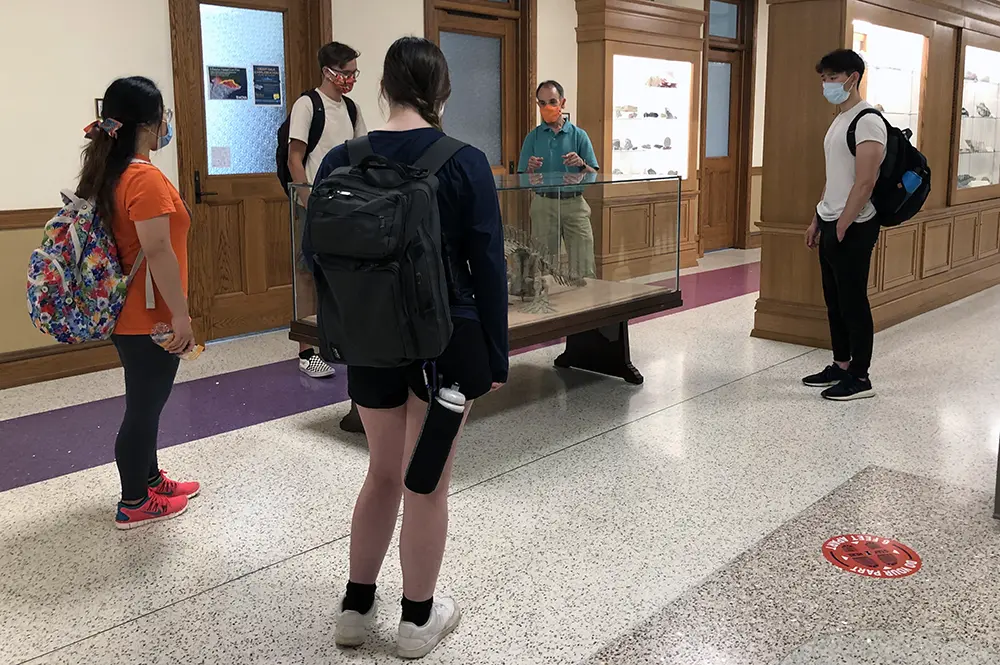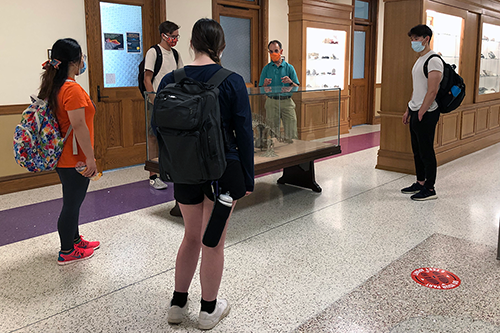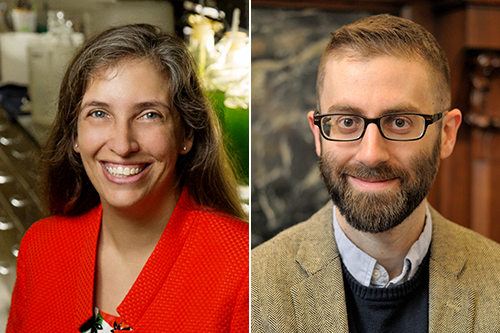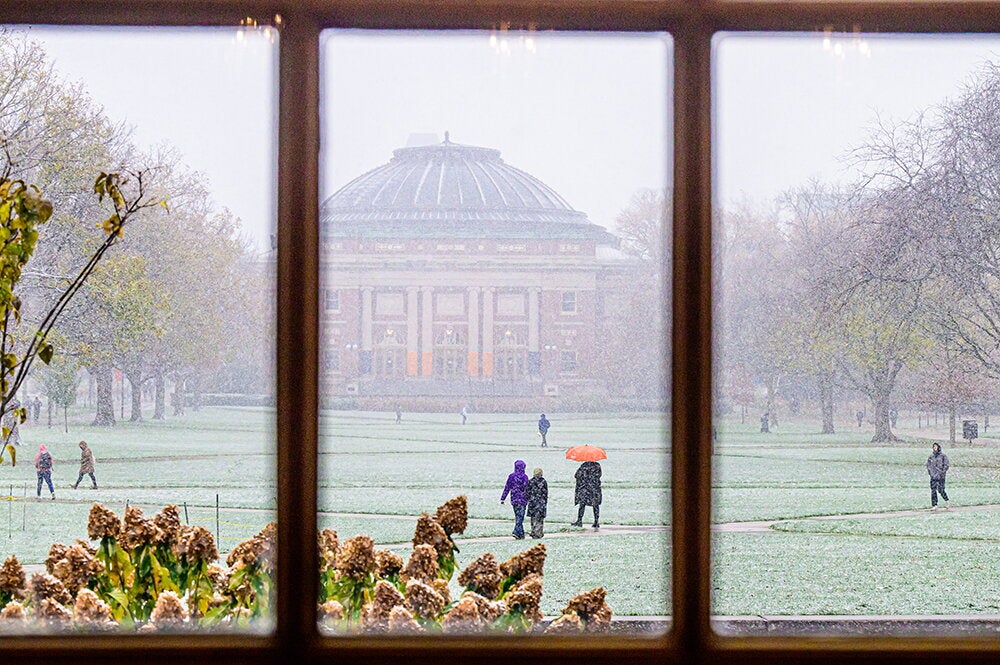

The fall semester is just weeks away, but preparations at the University of Illinois to create a meaningful, reliable, and safe learning experience during the COVID-19 pandemic have been progressing all summer long.
While the onset of the pandemic forced faculty, students, and administrators to finish about half of spring semester online, much was learned from the experience, and campus has used the summer break to prepare for a mix of online and face-to-face learning that will provide a full Illinois education.
“The fall semester is going to look different for all of us, but we are working hard and investing significant resources to provide students with an education that meets our high standards at the U of I,” said Gene Robinson, interim dean of the College of LAS. “We’re going to have new routines and ways of doing things, because the first priority is to be safe. We’ll adapt as we go along, if necessary, and I’m confident that this will be a successful fall semester.”
Kelly Ritter, associate dean for curricula and academic policy, said that the ratio of online learning to face-to-face instruction will vary from department to department and instructor to instructor. The majority of courses will be online, but some classes will maintain an in-person component if safety and adherence to social distancing guidelines allow it.
“Face-to-face learning could occur via outdoor meetings, indoor meetings with a subset of your classmates, one-on-one tutoring, and other options,” she said. “Meanwhile, we’ve been planning and building on pre-existing models to make online courses even more effective. Whether the courses are entirely online or a mix of online and in-person instruction, we want students to have a lively and interactive learning experience this fall, and we are confident that they will.”

In preparation for the fall, many professors and teaching assistants have taken advantage of the university’s Online Teaching Academy, which was created at the end of May by the Office of the Vice Chancellor and Provost for Academic Affairs to teach best methods for running online courses. More than 480 LAS faculty members and teaching assistants took part or have registered in June and July offerings of the academy, or have registered for the August offering. The campus-wide academy is led by Dawn Bohn, a teaching assistant professor of food science and human nutrition, and Kostas Yfantis, assistant director of Teaching & Learning with Technology in ATLAS, the College of LAS' technology services unit.
While some online courses will be conducted via Zoom, other online courses will feature pre-recorded lectures and provide an online component that allows for interaction separately. For example, David Dalpiaz, teaching assistant professor of statistics, has produced lecture videos from home for Statistics 432. One of them can be viewed here.
The School of Molecular and Cellular Biology produced a video for MCB 150, a large-enrollment introductory course that will be conducted remotely. Brad Mehrtens, instructor for MCB 150, said that the course will still meet online three times per week at a set time for lectures, with students meeting at a separate time of their choosing for discussion. The activities will be synchronous, allowing students and instructors to see each other and interact.
Every other week, students will have an assessment that Mehrtens described as a “quest”—which is “a little bigger than a quiz, a little smaller than a test.” Class periods will be based more on real-time activities rather than lectures. Other details are included in the video, which can be viewed here.
“We’re excited about this fall. We know that you’re going to be nervous, but that’s to be expected of any course,” said Mehrtens. “But we’re going to get through it, and we’re going to get through it together. And it’s going to be a positive experience.”
Dana Rabin, chair of the Department of History, said that several faculty have participated in the Online Teaching Academy. Rabin, who is teaching History 100 in the fall—the department’s largest course, with an enrollment of 300—has been recording lectures this summer to provide to the class when the semester starts.

The department has also hosted workshops on teaching online that covered topics such as the mechanics of filming and sound, assessing an online course, varying formats, how to facilitate active learning in synchronous formats such as Zoom, and innovative strategies and ideas, such as podcasts.
Carla Cáceres, director of the School of Integrative Biology, said that a few upper level courses in the school will have a face-to-face component, but undergraduates will have the option of completing most courses entirely online.
This decision was made for a few reasons: not all students will be able to participate in face-to-face courses and labs; students who test positive for COVID-19 but are asymptomatic still have the opportunity to complete their coursework; students can still complete their course if the state reverts to an earlier stage in the Restore Illinois plan; and many interactive laboratories and courses are not as effective under social distancing guidelines.
“Most of our laboratory and discussion activities are not possible with social distancing, but the student-centered group work that is the core of our curriculum is possible in well-designed online courses,” Cáceres said. “We are fortunate to have been offering fully online courses for over a decade and have many experts in distance learning.”
Mariselle Meléndez, head of the Department of Spanish & Portuguese, said that 100-level and 200-level courses in the department will be offered either through Zoom or through asynchronous online options. Course supervisors have been preparing virtual folders for teaching assistants that include recommendations for lesson planning, including best practices for the Zoom environment and alternatives for class activities that aren’t well-suited for Zoom.
Assessments—exams, quizzes, etc.—are also being re-evaluated for effectiveness, Meléndez said. Some courses will be lowering the weight of exams and incorporating in-class quizzes and writing assignments that contribute toward the final grade. For some courses at the 200 level, the course supervisor is considering quizzes to be open-book, and she will be incorporating oral interview sessions on Zoom. In Spanish 232: Spanish in the Community, which involves community service work, the service requirement will be replaced with virtual projects, and the instructors will bring several community members and leaders to the class via Zoom. Some upper level courses will maintain a face-to-face component if interaction is necessary, such as Spanish 324: Why We East What We Eat: Food and Culture in Colonial Latin America.
“What we know for sure is that as a department we are ready to deliver instruction in any platform required by the university. Our department has a long history of hybrid instruction, being one of the first in the nation in 1998 to introduce a hybrid component into our language courses,” she said. “Whether it’s remotely, online or in person, rest assured we will indeed deliver outstanding instruction to you.”


